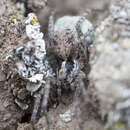Conservation Status
provided by University of Alberta Museums
Unknown. Its relative abundance and wide range suggest it is not a significant issue.
- license
- cc-by-nc
- copyright
- University of Alberta Museums
Cyclicity
provided by University of Alberta Museums
Adults have been found between May and August, egg sacs found from June to early September.
- license
- cc-by-nc
- copyright
- University of Alberta Museums
Distribution
provided by University of Alberta Museums
Throughout North America, save the southern United States.
- license
- cc-by-nc
- copyright
- University of Alberta Museums
General Description
provided by University of Alberta Museums
"Female: Total length 5.5-7.5 mm. Chelicerae and cephalothorax dark reddish-brown. Carapace has a pale stripe down the middle that widens towards its middle, and two submarginal stripes of similar color. Abdomen quite variable in color - may be gray or brown, sometimes with a row of chevrons, sometimes with black mottling. Hooded epigynum with one large cavity. Median septum is usually long, somewhat spatulate, and broad; and tapers significantly at its anterior end.
Male: Total length 6-6.5 mm. Color and pattern similar to female. Terminal apophysis long and fingerlike. Two processes on the median apophysis; the distal process is long enough to reach the edge of the genital bulb (the basal bulb process is sharp and short). Base of embolus is quite stout; almost straight at distal end and can be described as "bladelike". Tibia of palpus has many long, curved setae."
- license
- cc-by-nc
- copyright
- University of Alberta Museums
Habitat
provided by University of Alberta Museums
Coniferous forest, beaches and dunes, northern prairie, and alpine meadows and tundra.
- license
- cc-by-nc
- copyright
- University of Alberta Museums
Life Cycle
provided by University of Alberta Museums
" Pardosa concinna is fairly common throughout most of its range. Like all wolf spiders, it is an opportunistic ambush predator. Though it chases down its prey over short distances, P. concinna does not actively seek out its prey; rather, it waits for its prey to draw close to it - then strikes in a burst of speed. Prey is detected by visual stimuli, primarily by the large anterior median eyes. Webbing is not used in prey capture, but is used for draglines, nest lining, and the construction of egg cases.
Full maturity evidently takes about two years. Juveniles overwinter, grow the following season, overwinter again, and reach adulthood the following summer. Mating is precipitated by a visual display on the part of the male, and usually lasts about 15 minutes. Egg sacs are constructed from two separate halves that are attached to one another, hence its squashed-sphere shape. The egg sac is carried by the female for a few weeks, attached to her spinnerets, until such point as the juveniles are old enough to emerge, at which point she perforates it with her chelicerae to allow them to escape. The hatchlings clamber onto her abdomen and remain there for up to two weeks as they absorb their yolk sacs, clinging to specialized setae. The female's appetite is somewhat suppressed during this period, no doubt to reduce cannibalism!"
- license
- cc-by-nc
- copyright
- University of Alberta Museums
Trophic Strategy
provided by University of Alberta Museums
Ambush predator of a wide variety of terrestrial arthropods.
- license
- cc-by-nc
- copyright
- University of Alberta Museums

